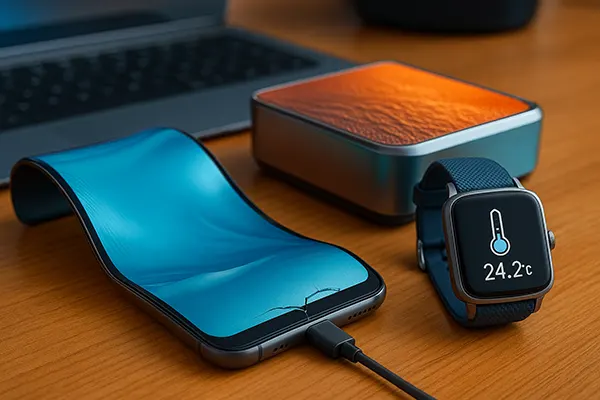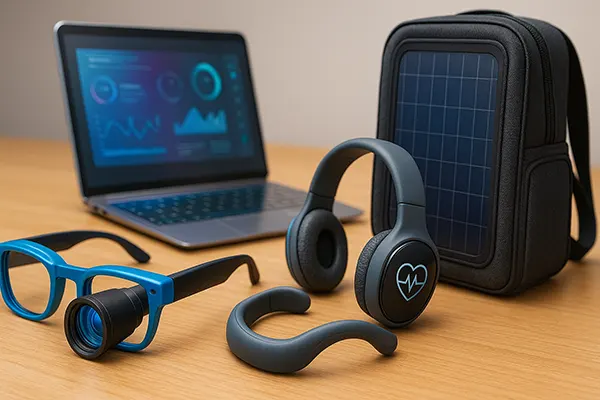Smart Materials in Gadgets: Shape-Shifting, Self-Healing and Temperature-Adaptive Innovations

Modern consumer electronics are no longer limited to traditional plastics, glass and metal. The rapid progress in material science has introduced so-called smart materials, capable of adapting to their environment, repairing themselves, or changing form when triggered by external factors. By 2025, these innovations are actively reshaping the way gadgets are designed and used, creating devices that are more durable, flexible, and responsive to user needs.
Shape-Memory and Flexible Materials in Consumer Devices
Shape-memory alloys (SMAs) and polymers are increasingly employed in smartphones, wearables, and even laptops. These materials return to their original form after being bent or deformed when exposed to heat or an electrical current. For instance, flexible smartphone prototypes use shape-memory polymers to fold and unfold without permanent damage, offering greater portability without compromising screen integrity.
Another area of development is foldable screens reinforced with advanced polymers. Unlike early foldable devices, which often suffered from creasing and durability problems, by 2025 manufacturers have adopted hybrid structures combining graphene layers with flexible substrates. This provides resilience while maintaining image clarity and touch sensitivity, addressing earlier market concerns.
In addition, flexible sensors based on conductive elastomers allow wearable devices to seamlessly adapt to the body’s movements. Fitness trackers and medical monitors equipped with such sensors provide continuous, accurate readings without discomfort, expanding their usability for long-term health applications.
Real-World Applications of Shape-Adaptive Gadgets
Beyond consumer electronics, shape-memory materials are being introduced in accessories such as smart glasses. Frames can adapt to facial contours, ensuring better comfort and fit, while lenses can automatically adjust curvature for improved focus or augmented reality displays. This reduces strain for users and personalises the experience in real time.
Portable keyboards and peripherals are also benefiting from shape-shifting designs. Rollable keyboards made from elastic conductive polymers can expand into full size when in use and contract for storage, making them highly convenient for mobile professionals. The combination of elasticity and conductivity allows seamless integration with Bluetooth systems without loss of sensitivity.
Even protective casings for smartphones and tablets are moving towards adaptive solutions. Materials with embedded microstructures can stiffen during impact to protect devices yet remain flexible during regular handling. This dual performance reduces the need for bulky covers and adds a new level of user confidence.
Self-Healing Surfaces and Their Role in Durability
One of the most remarkable innovations in recent years is the use of self-healing polymers. These materials contain reversible chemical bonds or microcapsules filled with healing agents that activate when scratches or cracks appear. In 2025, leading electronics brands are applying this technology to smartphone screens, smartwatch cases, and laptop covers to extend the lifespan of devices significantly.
Self-healing displays are particularly important in markets where device replacement cycles are slowing down. Instead of replacing a gadget every two years, consumers can rely on surfaces that automatically repair minor scratches within hours. This not only reduces waste but also supports sustainability initiatives in the electronics industry.
The automotive industry has been an early adopter of self-healing coatings, and this knowledge is now directly influencing gadget production. Manufacturers are integrating these materials in protective films and coatings for portable devices, ensuring that everyday wear and tear does not compromise performance or aesthetics.
Challenges and Limitations of Self-Healing Materials
While progress is impressive, self-healing materials are not yet flawless. They often take several hours to repair visible damage, and deeper cracks still require manual intervention. Moreover, the durability of repeated healing cycles remains a concern for long-term use. Researchers are actively working on improving chemical compositions to allow multiple healing events without degradation.
Cost is another barrier. Incorporating self-healing technology into mass-market electronics raises production expenses. However, as demand grows and methods of large-scale production are refined, it is expected that prices will drop, making these features standard in mid-range devices as well.
Finally, consumer trust in new materials is crucial. While early adopters may appreciate the innovation, many users still prefer traditional durability solutions, such as tempered glass or protective cases. Educating the market about the reliability and benefits of self-healing technology is essential for widespread adoption.

Temperature-Adaptive Gadgets and Thermal Comfort
Another transformative area is the development of temperature-responsive materials. These substances change properties such as conductivity, opacity, or rigidity depending on environmental conditions. For instance, laptops and gaming consoles now incorporate phase-change materials (PCMs) that absorb and release heat, maintaining optimal internal temperatures and reducing reliance on noisy cooling fans.
Wearable devices, including smartwatches and medical trackers, also benefit from thermochromic polymers and adaptive textiles. Straps can adjust their flexibility in response to body temperature, improving comfort during extended wear. At the same time, sensors embedded in these materials provide real-time thermal monitoring, useful for sports performance and medical diagnostics.
Smart materials are also enhancing user safety. For example, protective covers for batteries and power banks are now engineered with temperature-sensitive layers that expand or contract to prevent overheating, significantly reducing fire risks associated with lithium-ion cells. This represents a major advancement in portable electronics safety.
Future Prospects for Thermal-Adaptive Gadgets
Looking ahead, temperature-adaptive materials may play a role in the development of energy-efficient gadgets. By regulating heat transfer, devices can operate at lower power levels, extending battery life and reducing environmental impact. This has clear implications for sustainable technology design.
Thermochromic coatings are expected to expand beyond wearables into everyday electronics. Devices such as tablets could feature screens that automatically adjust brightness and colour tone in response to surrounding temperatures, reducing eye strain and energy consumption. This would enhance user comfort in diverse environments without manual adjustment.
Research is also exploring integration of temperature-adaptive materials in flexible batteries. Such batteries could maintain consistent performance even in extreme climates, opening possibilities for gadgets designed for outdoor exploration, space applications, or military use where reliability is critical under shifting conditions.




